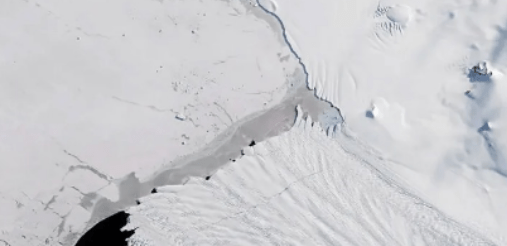
Scientists have delved into Antarctica’s history to unravel the enigma of the “Doomsday Glacier,” Thwaites Glacier, whose potential collapse poses a looming threat of catastrophic sea level rise. A recent study sheds light on the glacier’s past, revealing a rapid retreat that commenced in the 1940s, a critical insight into the trajectory of future melting.
READ: New York Businesses Ordered to Require Masks Indoors or Vaccine Proof
Antarctica’s
Thwaites Glacier, situated in West Antarctica, holds the title of the world’s widest, roughly equivalent to the size of Florida. While the accelerated loss of ice has been observed since the 1970s, the exact onset of significant melting remained uncertain due to the limited timeline of satellite data. However, a study published in the Proceedings of the National Academy of Sciences provides a breakthrough by examining marine sediment cores extracted from beneath the ocean floor.
The analysis indicates that the glacier’s substantial retreat began in the 1940s, potentially triggered by a powerful El Niño event—a natural climate fluctuation known for its warming impact. Despite subsequent years, the glacier has failed to recover, suggesting an escalating influence of human-induced global warming.
The implications of Thwaites Glacier’s fate extend far beyond its immediate surroundings, contributing 4% to current sea level rise by releasing billions of tons of ice annually. A complete collapse could elevate sea levels by more than 2 feet. Moreover, the glacier plays a pivotal role in stabilizing the West Antarctic Ice Sheet, acting as a cork restraining the vast expanse of ice behind it. Its collapse could compromise the entire ice sheet, capable of raising sea levels by at least 10 feet and triggering widespread global flooding.
The study aligns with previous research on the neighboring Pine Island Glacier, emphasizing the broader context of climate change. Julia Wellner, an associate professor of geology and study co-author, underscores the significance of simultaneous retreats in both glaciers, indicating a shared force influencing their behavior.
To reconstruct Thwaites’ nearly 12,000-year history, scientists collected ocean sediment cores from an icebreaker vessel, offering a historical timeline. The melting initiation in the 1940s appears linked to an extreme El Niño, exacerbating the glacier’s existing melting phase. The findings underscore the difficulty of halting significant changes once triggered, emphasizing the long-lasting impact of climate-induced alterations.
While past retreats allowed ice sheets to recover, the current scenario offers no signs of restoration, pointing towards the escalating influence of human-induced climate change. The study reinforces the notion that even minor continuous climate changes can lead to significant shifts in glacier states, emphasizing the vulnerability of Antarctica amid ongoing global warming.